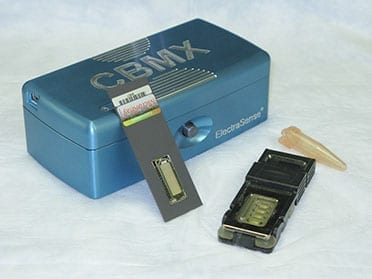 Scientists from the U.S. Naval Research Laboratory (NRL) and Naval Medical Research Unit 2 (NAMRU-2) recently conducted on-site testing in Phnom Penh, Cambodia for the NRL-developed Antimicrobial Resistance Determinant Microarray.
Scientists from the U.S. Naval Research Laboratory (NRL) and Naval Medical Research Unit 2 (NAMRU-2) recently conducted on-site testing in Phnom Penh, Cambodia for the NRL-developed Antimicrobial Resistance Determinant Microarray.
The joint NRL-NAMRU-2 team successfully carried out testing and technology
transition of the NRL-developed Antimicrobial Resistance Determinant Microarray (ARDM) to the NAMRU-2 satellite laboratory at the National Institutes of Public Health in Phnom Penh, Cambodia. This was the first time the technology has been tested outside of the NRL laboratory setting.
Drs. Gary Vora, Tomasz Leski, and Chris Taitt, scientists from the NRL Center for Bio-Molecular Science and Engineering developed the ARDM to provide simultaneous DNA-based analysis for hundreds of resistance genes. This array works quickly to determine resistant genetic assemblages and also to monitor the spread and evolution of antibiotic resistance.
During the tests in Cambodia, June 1 – 16, Dr. Chris Taitt and NAMRU-2’s LCDR Michael Prouty used the ARDM to test more than 50 drug-resistant pathogens and wound isolates, including the methicillin-resistant Staphylococcus aureus (MRSA). Relatively small and speedy, the ARDM can simultaneously detect hundreds of pathogens, the agents that cause disease, with just one-day turnaround time.
The ARDM testing indicated a widespread distribution of genes causing resistance to both first- and last-line antibiotics within this region, explained Dr. Taitt. She notes that it was interesting to learn that the types and levels of multidrug resistance in Phnom Penh were found to be different from those of similar bacterial pathogens tested from the Middle East, South America, and North and West Africa.
The data collected using the ARDM is critical in steering medical personnel towards strategies with the highest chances of success when treating sailors and soldiers deployed to these regions. This knowledge also will enable epidemiologists to track the spread of new and emerging sources of resistance, while also providing guidance for public health and antimicrobial administration policies for more timely response to infectious disease outbreaks.
The testing that NRL and NAMRU-2 conducted in Cambodia in June resulted in the first molecular epidemiological characterization of antibiotic resistance genes and resistance trends from bacterial enteric pathogens in Cambodia and also contributed to an expanding database of global antibiotic resistance gene signatures.
Using the ARDM to study antibiotic resistance in different regions, such as Cambodia, NRL researchers have made the surprising discovery that there are geographic difference in the resistance genes, and that some of these genes could be resistant to entire classes of antibiotics. Armed with the ARDM, researchers can now help to provide the military with knowledge that helps them defend against these diseases they might encounter around the world.
Image: The array is the size of a microscope slide and the reader (blue box) is the size of a brick. Other readers are typically the size of a standard microwave oven. So the NRL-developed ARDM offers a tremendous savings in size and speed.
(Photo: U.S. Naval Research Laboratory/Dr. Joel Golden)
Source: Adapted from NRL press release


